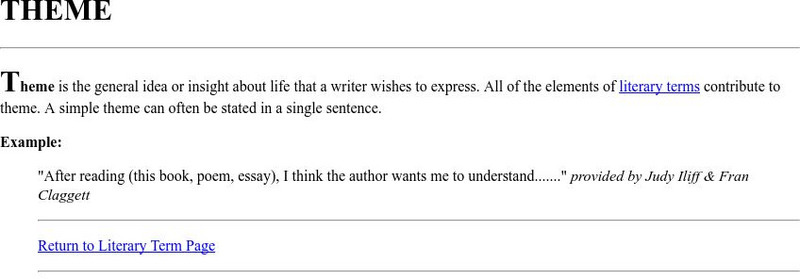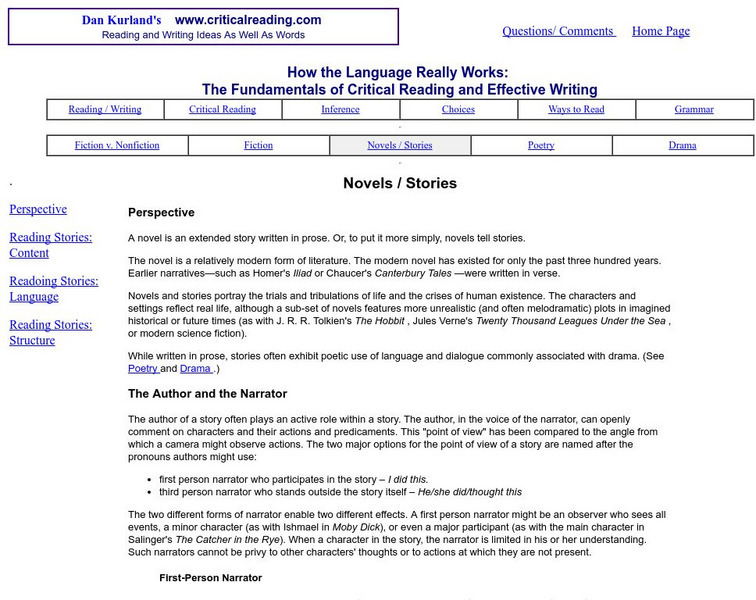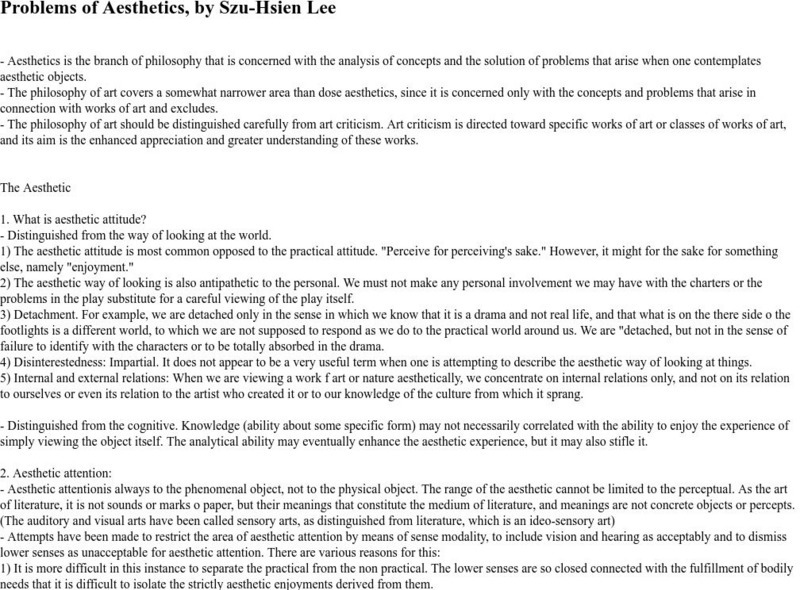Pennsylvania State University
Pennsylvania State University (Dr. Mc Clennen): How to Do a Close Reading
This guide is written for college students, but should be very useful for upper level high school students as well. The writer first describes fourteen steps to take in doing a close reading, then provides six pieces of advice on how to...
Other
Wisewire: Grades 9 10 Playlist: Analyze How an Author Unfolds an Argument
This is an example of how to analyze how an author unfolds an argument. It provides an example and links to use for practice. RI.9-10.3 author unfolds
Texas Education Agency
Texas Gateway: Literary Text: Diction and Tone
This lesson deals primarily with diction and tone and how to recognize them in your reading. Tone is largely determined by diction or the word choices a writer makes. The process of choosing the right word involves denotation and...
Common Sense Media
Common Sense Media: Character Development and Relationships in Hamlet
A lesson plan relating to Hamlet whose objective is to able to "analyze how and why individuals, events, and ideas develop and interact over the course of a text". Lesson includes a hook, direct instruction, guided practice, and...
Other
Short Story Elements
Geared toward high school students, this site contains many notes and links on the aspects of short story, figurative language, and figures of speech.
Georgia Department of Education
Ga Virtual Learning: "Elements of Drama" [Pdf]
This two-page PDF provides a list and brief explanation of the "Elements of Drama" based on the structure of Greek Drama as outlined by Aristotle. These include: Thought, Theme, Ideas; Action, Plot; Characters, Language, Music, and...
Alabama Learning Exchange
Alex: Analyzing Characters in 12 Angry Men
Re-telling a story from the points of view of its various characters is a powerful way to review the events of a story, show how authors use characterization to reveal characters' personalities, and encourage students to view stories...
PBS
Pbs Learning Media: Literary Elements and Techniques: Symbolism
Explore how authors use symbolism to add a deeper level of meaning to their work in this short animated video [1:12] from WNET. Discussion questions below help students to further apply their understanding before analyzing a text.
Ted Nellen
Cyber English (By Ted Nellen): Bildungsroman
This is a glossary entry for the term "Bildungsroman" referring to characteristics of a "Coming Of Age" type story. A link to more information is provided.
Ted Nellen
Cyber English (By Ted Nellen): Theme
This is a glossary entry for the term "Theme" including a definition and an example.
Other
How the Language Really Works: Novels and Stories
This brief article explains perspective, types of narrators, and the elements of fiction.
Other
Problems of Aesthetics, by Szu Hsien Lee
Defines the term aesthetics in a number of different contexts including both the philosophy of art and the criticism of art. This is a fairly clear discussion of a rather complex topic broken down into a number of subsections. Although...
University of Victoria (Canada)
The U Vic Writer's Guide: Literary Term: Theme
This site provides a general description of theme, complete with a couple of examples.
University of Victoria (Canada)
The U Vic Writer's Guide: Literary Term: Motif
This site from The UVic Writer's Guide provides a brief description of the literary term "motif."
Houghton Mifflin Harcourt
Holt, Rinehart and Winston: Elements of Literature: The Short Story [Pdf]
A short group of exercises for students concerning the elements of a short story. Allows students to examine the major story elements, then apply those elements to a given piece of literature.
Houghton Mifflin Harcourt
Holt, Rinehart and Winston: Elements of Literature: Determining Methods of Characterization [Pdf]
A brief organizer in which students can document how a character in literature is presented, through either direct or indirect characterization. Provides labels, examples, and sections for textual support.
ClassFlow
Class Flow: Short Story Unit Applying Literary Terms
[Free Registration/Login Required] This flipchart is a review and assessment of a collection of short stories. The following literary terms are applied to the stories: plot structure, types of characters, characterization, irony,...
Other
Mantex: Tutorials: What Is Close Reading?
This site discusses the four types of reading: Linguistic, Semantic, Structural, and Cultural and offers a detailed example of close reading. RL.11-12.3 Auth choice story elem, RL.11-12.5 Choice of Text Structure
Austin Independent School District
Austin Independent School: Symbolism, Tone, and Mood [Pdf]
Click through this PDF slideshow to learn what a symbol is and how symbolism is used in literature. Then learn about the difference between tone and mood and see examples of each in a poem.
Austin Independent School District
Austin Independent School District: Examining Tone in Literature [Pdf]
Click through this PDF slide presentation to learn a definition of tone and to gain a better understanding of how it is used in literature. Slides include activities to help students see the effect of using different tones and examples...
University of Victoria (Canada)
The U Vic Writer's Guide: Literary Term: Humour
This site from The UVic Writer's Guide provides a general description of the term humour. Content includes a literary example.
Authors Calendar
Author's Calendar: Roland Barthes Structuralist
Biography of a major proponent of structuralism. Provides life info and brief mention of his various work.












![Holt, Rinehart and Winston: Elements of Literature: The Short Story [Pdf] Unit Plan Holt, Rinehart and Winston: Elements of Literature: The Short Story [Pdf] Unit Plan](http://content.lessonplanet.com/resources/thumbnails/410057/large/bwluav9tywdpy2symdiwmduymc03ode4lte1bw5wdgouanbn.jpg?1589985144)
![Holt, Rinehart and Winston: Elements of Literature: Determining Methods of Characterization [Pdf] Graphic Holt, Rinehart and Winston: Elements of Literature: Determining Methods of Characterization [Pdf] Graphic](http://content.lessonplanet.com/resources/thumbnails/410109/large/bwluav9tywdpy2symdiwmduymc0ymjy4mc0xz3pvamf3lmpwzw.jpg?1589985471)

